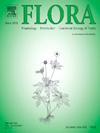Pollination of Disa engleriana (Orchidaceae): Floral modifications for deposition of pollinaria on the abdomen of large bees and wasps
Abstract
The evolution of complex floral morphology in orchids can be attributed largely to mechanisms that ensure precise placement of pollinaria on the bodies of animal flower visitors. Floral advertisements and rewards also play a key role in selective attraction of animals that are suitable as pollen vectors. Previous studies of the large African orchid genus Disa have demonstrated high levels of pollination system specialization and have identified functions of floral morphology for transfer of pollen, but studies of pollination in members of the tropical clade of Disa sect. Micranthae have been lacking. This clade is characterized by highly unusual floral morphology, including vertical anthers and pronounced spatial separation between a nectar-producing spur located in the centre of the dorsal sepal and the rostellum lobes that serve to attach pollinaria to flower visitors. In a study conducted in central Zambia, I found that the flowers of Disa engleriana are pollinated by large wasps (Eumeninae and Scoliidae) and carpenter bees. These insect groups carry pollinaria near the tip of their abdomen, which contacts the rostellum when the abdomen is tucked under the flower for balance during nectar-feeding. The pollinaria are rigid and project at 90˚ from the underside of the abdomen such that they contact the deeply recessed stigma during subsequent flower visits. This study reveals a new mechanism of pollen transfer in Disa and sheds light on the evolution of the highly complex floral morphology of this large orchid clade

 求助内容:
求助内容: 应助结果提醒方式:
应助结果提醒方式:


